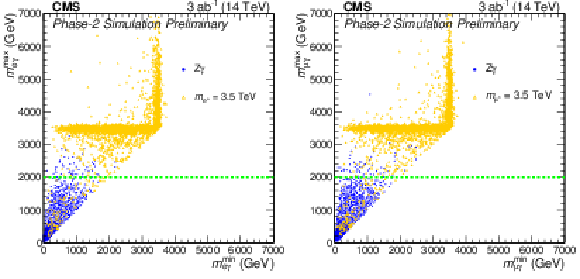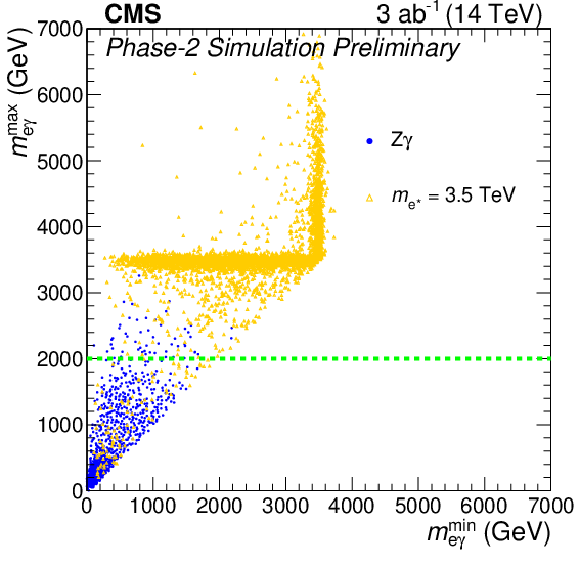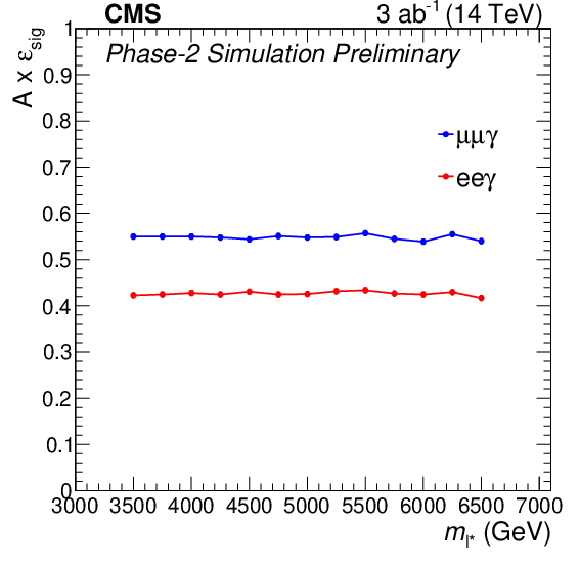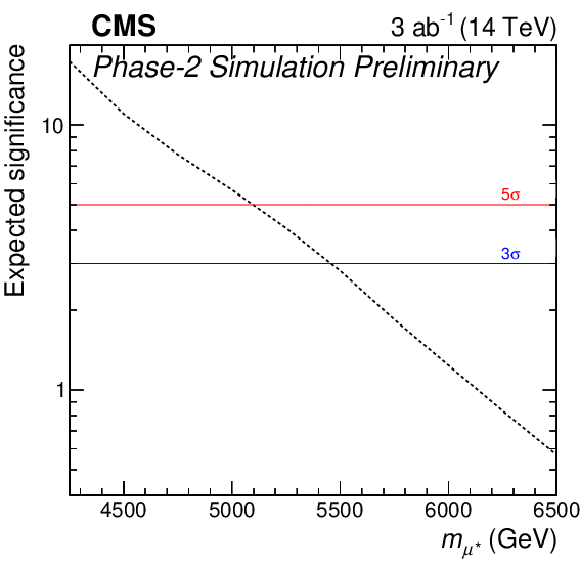

Compact Muon Solenoid
LHC, CERN
| CMS-PAS-FTR-18-029 | ||
| Search for excited leptons in $\ell \ell \gamma$ final states in proton-proton collisions at the HL-LHC | ||
| CMS Collaboration | ||
| December 2018 | ||
| Abstract: A search for excited leptons (electrons and muons) is presented, using simulation of the upgraded CMS detector at the High-Luminosity LHC (HL-LHC). Excited leptons are predicted by many theories beyond the standard model (SM) where quarks and leptons are not elementary but instead are themselves composite objects. Excited leptons ($\ell^* = e^*$, $\mu^*$) in $\ell\ell\gamma$ ($\ell=$ e, $\mu$) final states where the excited lepton decays to a SM lepton and a photon ($\ell^*\rightarrow\ell\gamma$) are studied. The main background is Drell-Yan production in association with a photon. The HL-LHC environment (a centre of mass energy of 14 TeV and an integrated luminosity of 3000 fb$^{-1}$) allows for an extension of the discovery potential for excited leptons. The analysis is optimised for HL-LHC conditions, and indicates that 5$\sigma$ discovery of excited leptons is possible for masses up to 5.1 TeV. If no significant discrepancies are seen in the data, excited leptons with masses below 5.8 TeV could be excluded at 95% confidence level. | ||
| Links: CDS record (PDF) ; inSPIRE record ; CADI line (restricted) ; | ||
| Figures | |

png pdf |
Figure 1:
The Feynman diagram of the production of excited leptons in $\ell \ell \gamma $ final states. |

png pdf |
Figure 2:
2D $ {m_{\ell \gamma}^\text {max}} $ versus $ {m_{\ell \gamma}^\text {min}} $ distribution after full selection with $ {\mathrm {Z}} \gamma$ background (blue circles) and signal ${e}^{*}$ and ${\mu}^{*}$ samples of ${m_{\ell ^*}} =$ 3.5 TeV (orange triangles) in the electron channel (left) and muon channel (right). The dashed green line indicates the lower bound of the search window. |

png pdf |
Figure 2-a:
2D $ {m_{\ell \gamma}^\text {max}} $ versus $ {m_{\ell \gamma}^\text {min}} $ distribution after full selection with $ {\mathrm {Z}} \gamma$ background (blue circles) and signal ${e}^{*}$ and ${\mu}^{*}$ samples of ${m_{\ell ^*}} =$ 3.5 TeV (orange triangles) in the electron channel. The dashed green line indicates the lower bound of the search window. |

png pdf |
Figure 2-b:
2D $ {m_{\ell \gamma}^\text {max}} $ versus $ {m_{\ell \gamma}^\text {min}} $ distribution after full selection with $ {\mathrm {Z}} \gamma$ background (blue circles) and signal ${e}^{*}$ and ${\mu}^{*}$ samples of ${m_{\ell ^*}} =$ 3.5 TeV (orange triangles) in the muon channel. The dashed green line indicates the lower bound of the search window. |

png pdf |
Figure 3:
The product of signal acceptance and efficiency as a function of the generated resonance mass for the $ {\mathrm {e}} {\mathrm {e}}\gamma $ (lower) and $ {{\mu}} {{\mu}}\gamma $ (upper) channels. Each marker denotes the value measured from the simulated signal sample at a given mass point. |

png pdf |
Figure 4:
Discovery significance for excited electrons (left) and muons (right) with 3000 fb$^{-1}$ at the HL-LHC. |

png pdf |
Figure 4-a:
Discovery significance for excited electrons with 3000 fb$^{-1}$ at the HL-LHC. |

png pdf |
Figure 4-b:
Discovery significance for excited muons with 3000 fb$^{-1}$ at the HL-LHC. |

png pdf |
Figure 5:
Exclusion limits for excited electrons (left) and muons (right) on the product of cross section and branching fraction. |

png pdf |
Figure 5-a:
Exclusion limits for excited electrons on the product of cross section and branching fraction. |

png pdf |
Figure 5-b:
Exclusion limits for excited muons on the product of cross section and branching fraction. |
| Tables | |

png pdf |
Table 1:
Summary of the systematic uncertainties. |
| Summary |
| The search for excited leptons in final states with two leptons and a photon in proton-proton collisions at the High-Luminosity LHC (HL-LHC) is studied. The HL-LHC environment (a centre of mass energy of 14 TeV and an integrated luminosity of 3 ab$^{-1}$) allows for an extension of the discovery potential for excited leptons. The results are optimised for HL-LHC conditions, and it is found that excited leptons masses up to 5.5 (5.1) TeV can be excluded (discovered), for both excited electrons and excited muon states. Excited leptons could be excluded for masses below 5.8 TeV, at 95% confidence level. |
| References | ||||
| 1 | O. W. Greenberg and C. A. Nelson | Composite models of leptons | PRD 10 (1974) 2567 | |
| 2 | J. C. Pati, A. Salam, and J. A. Strathdee | Are quarks composite? | PLB 59 (1975) 265 | |
| 3 | O. W. Greenberg and J. Sucher | A quantum structure dynamic model of quarks, leptons, weak vector bosons, and Higgs mesons | PLB 99 (1981) 339 | |
| 4 | H. Terazawa, M. Yasu\`e, K. Akama, and M. Hayshi | Observable effects of the possible substructure of leptons and quarks | PLB 112 (1982) 387 | |
| 5 | M. Abolins et al. | Testing the Compositeness of Quarks and Leptons | in Elementary Particles and Future Facilities (Snowmass 1982), p. 274 1982eConf C8206282 | |
| 6 | E. Eichten, K. D. Lane, and M. E. Peskin | New Tests for Quark and Lepton Substructure | PRL 50 (1983) 811 | |
| 7 | H. Harari | Composite models for quarks and leptons | Physics Reports 104 (1984) 159 | |
| 8 | U. Baur, M. Spira, and P. M. Zerwas | Excited quark and lepton production at hadron colliders | PRD 42 (1990) 815 | |
| 9 | S. Bhattacharya, S. S. Chauhan, B. C. Choudhary, and D. Choudhury | Search for excited quarks in $ q\overline{q} {\rightarrow} {\gamma} {\gamma} $ at the CERN LHC | PRD 76 (2007) 115017 | 0705.3472 |
| 10 | S. Bhattacharya, S. S. Chauhan, B. C. Choudhary, and D. Choudhury | Quark Excitations Through the Prism of Direct Photon Plus Jet at the LHC | PRD 80 (2009) 015014 | 0901.3927 |
| 11 | G. Apollinari et al. | High-Luminosity Large Hadron Collider (HL-LHC) : Preliminary Design Report | ||
| 12 | CMS Collaboration | Technical Proposal for the Phase-II Upgrade of the CMS Detector | CMS-PAS-TDR-15-002 | CMS-PAS-TDR-15-002 |
| 13 | CMS Collaboration | The Phase-2 Upgrade of the CMS Tracker | CDS | |
| 14 | CMS Collaboration | The Phase-2 Upgrade of the CMS Barrel Calorimeters Technical Design Report | CDS | |
| 15 | CMS Collaboration | The Phase-2 Upgrade of the CMS Endcap Calorimeter | CDS | |
| 16 | CMS Collaboration | The Phase-2 Upgrade of the CMS Muon Detectors | CDS | |
| 17 | CMS Collaboration | Expected performance of the physics objects with the upgraded CMS detector at the HL-LHC | CDS | |
| 18 | ATLAS Collaboration | Search for excited leptons in proton-proton collisions at $ \sqrt{s} = $ 7~TeV with the ATLAS detector | PRD 85 (2012) 072003 | 1201.3293 |
| 19 | ATLAS Collaboration | Search for excited electrons and muons in $ \sqrt{s} = $ 8~TeV proton-proton collisions with the ATLAS detector | New J. Phys. 15 (2013) 093011 | 1308.1364 |
| 20 | ATLAS Collaboration | A search for an excited muon decaying to a muon and two jets in pp collisions at $ \sqrt{s} = $ 8 TeV with the ATLAS detector | New J. Phys. 18 (2016) 073021 | 1601.05627 |
| 21 | CMS Collaboration | Search for excited leptons in $ pp $ collisions at $ \sqrt{s}= $ 7 TeV | PLB 720 (2013) 309 | CMS-EXO-11-034 1210.2422 |
| 22 | CMS Collaboration | Search for excited leptons in proton-proton collisions at $ \sqrt{s} = $ 8~TeV | JHEP 03 (2016) 125 | CMS-EXO-14-015 1511.01407 |
| 23 | CMS Collaboration | Search for excited leptons in $ {\ell \ell \gamma} $ final states in proton-proton collisions at $ \sqrt{s} = $ 13 TeV | CMS-PAS-EXO-18-004 | CMS-PAS-EXO-18-004 |
| 24 | ALEPH Collaboration | Search for excited leptons at 130--140 GeV | PLB 385 (1996) 445 | |
| 25 | DELPHI Collaboration | Search for composite and exotic fermions at LEP 2 | EPJC 8 (1999) 41 | hep-ex/9811005 |
| 26 | OPAL Collaboration | Search for unstable heavy and excited leptons at LEP 2 | EPJC 14 (2000) 73 | hep-ex/0001056 |
| 27 | L3 Collaboration | Search for excited leptons at LEP | PLB 568 (2003) 23 | hep-ex/0306016 |
| 28 | H1 Collaboration | Search for excited electrons in $ ep $ collisions at HERA | PLB 666 (2008) 131 | 0805.4530 |
| 29 | CDF Collaboration | Search for Excited and Exotic Electrons in the $ e\gamma $ Decay Channel in $ \rm {p}\overline{\rm p} $ Collisions at $ \sqrt{s} = $ 1.96 TeV | PRL 94 (2005) 101802 | hep-ex/0410013 |
| 30 | CDF Collaboration | Search for Excited and Exotic Muons in the $ \mu\gamma $ Decay Channel in $ \rm {p}\overline{\rm p} $ Collisions at $ \sqrt{s} = $ 1.96 TeV | PRL 97 (2006) 191802 | hep-ex/0606043 |
| 31 | D0 Collaboration | Search for excited muons in $ {p}\overline{p} $ collisions at $ \sqrt{s} = $ 1.96 TeV | PRD 73 (2006) 111102 | hep-ex/0604040 |
| 32 | D0 Collaboration | Search for excited electrons in $ {p}\overline{p} $ collisions at $ \sqrt{s} = $ 1.96 TeV | PRD 77 (2008) 091102 | 0801.0877 |
| 33 | T. Sjostrand, S. Mrenna, and P. Z. Skands | PYTHIA 6.4 physics and manual | JHEP 05 (2006) 026 | hep-ph/0603175 |
| 34 | J. Alwall et al. | MadGraph 5: going beyond | JHEP 06 (2011) 128 | 1106.0522 |
| 35 | J. Alwall et al. | The automated computation of tree-level and next-to-leading order differential cross sections, and their matching to parton shower simulations | JHEP 07 (2014) 079 | 1405.0301 |
| 36 | J. de Favereau et al. | DELPHES 3, A modular framework for fast simulation of a generic collider experiment | JHEP 02 (2014) 057 | 1307.6346 |
| 37 | CMS Collaboration | Constraints on the Higgs boson self-coupling from ttH + tH, H $ \rightarrow \gamma\gamma $ differential measurements at the HL-LHC | CMS-PAS-FTR-18-020 | CMS-PAS-FTR-18-020 |
| 38 | CMS Collaboration | Projected performance of Higgs analyses at the HL-LHC for ECFA 2016 | CDS | |
| 39 | T. Junk | Confidence level computation for combining searches with small statistics | NIMA 434 (1999) 435 | hep-ex/9902006 |
| 40 | A. L. Read | Presentation of search results: the $ CL_s $ technique | JPG 28 (2002) 2693 | |

|
Compact Muon Solenoid LHC, CERN |

|

|

|

|

|

|